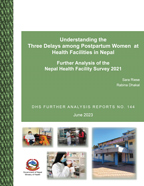- PUBLICATIONS
- JOURNAL ARTICLES
- ACCESS PUBLICATIONS
Publications Summary
- Document Type
- Further Analysis
- Publication Topic(s)
- Maternal Health, Maternal Mortality
- Country(s)
- Nepal
- Survey
- Nepal SPA, 2021
- Language
- English
- Recommended Citation
- Riese, Sara, and Rabina Dhakal. 2023. Understanding the Three Delays among Postpartum Women in Nepal. DHS Further Analysis Report No. 144. Rockville, Maryland, USA: ICF.
- Download Citation
- RIS format / Text format / Endnote format
- Publication Date
- June 2023
- Publication ID
- FA144
Download
 Understanding the Three Delays among Postpartum Women at Health Facilities in Nepal: Further Analysis of the Nepal Health Facility Survey 2021 (PDF, 2019K)
Understanding the Three Delays among Postpartum Women at Health Facilities in Nepal: Further Analysis of the Nepal Health Facility Survey 2021 (PDF, 2019K)
Download this publication
There is no printed copy available to order.
